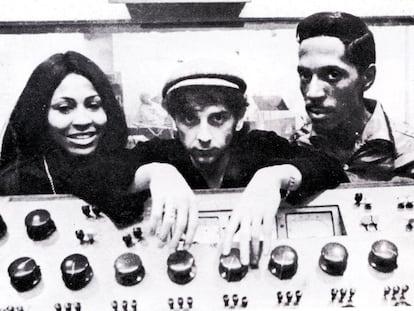Tina Turner’s many resurrections
The documentary ‘Remembering Tina Turner’ barely scratches the surface of the queen of rock. A previous film, ‘Tina,’ is much more ambitious, as befits a star who overcame enormous obstacles

Tina Turner’s first resurrection was when she woke up from a drug overdose and said, “Shit, I’m still here.” It was 1968 and she was fed up with the brutality of her husband and artistic partner, Ike Turner. She was resurrected again in 1976, when, during a night of beatings, she escaped from the Dallas hotel where they were staying with only the clothes on her back and took refuge in another one, on the other side of the freeway, which she would pay for later. She never returned to him, not even when they were inducted into the Rock and Roll Hall of Fame together. She was resurrected once again in 1981, when she decided to tell People magazine about the hell she had endured with Ike: “I didn’t fear him killing me when I left, because I was already dead.” Gender violence was not often talked about; public opinion sided with her. Her definitive resurrection came in 1984, when her album Private Dancer catapulted her to the stardom she had experienced before; however, this time she was alone and chose songs she did not write herself but that said things like: “What’s Love Got to Do with It?,” “Better Be Good to Me” and “Show Some Respect.”
Before all that, the young Anna Mae Bullock — who would later take the name Tina Turner that Ike gave her — had overcome a childhood influenced by poverty in the segregated American South (Memphis, land of great musicians) and her parents’ abandonment. She became a star in Saint Louis thanks to her prodigious voice and an unparalleled stage presence. She danced like no one else, even as she wore high heels; Mick Jagger is said to have based his style on an imitation of her. Ever since she started, she was compared to a wild and sensual beast, at a time when female singers were asked to be more modest.
Following her death in May of last year, a rushed documentary, Remembering Tina Turner, came out on Amazon Prime Video. It was too rushed: the film lasts just over 40 minutes, quickly goes through key moments of her life and relies mostly on the comments of two experts, cultural historian Jennifer Otter Bickerdike and journalist Afua Hagan, along with brief quotes from the singer herself. We can barely hear a few seconds of her most representative songs and performances. It is one of those cheap products that fill the streaming service’s menu and seem designed by an algorithm.
Tina is the much better choice. Dan Lindsay and TJ Martin’s ambitious documentary included the participation of the artist and her entourage. It is the story she wanted to tell in 2019, by way of farewell, after a decade had gone by since she had given up her career and the musical that bore her name was released. She looked back without anger. At the time, she already had health problems (a stroke, cancer, a kidney transplant, about which the film does not go into detail). The documentary features tons of valuable archival footage, her music is enjoyable, and all the important people in her story are there. Even Ike the monster (through a 2000 interview; he died in 2007), who is hesitant and insecure. He doesn’t admit to abuse, though he does concede he was unfaithful. His self-centeredness led him to blurt out that Tina’s problem was that “she wanted to be what she thought I wanted her to be.”
Ike was as violent and despotic as he was talented. He was frustrated at not being recognized as one of the pioneers of rock and roll (which he was with Rocket 88, in 1951). When they met in Saint Louis, Tina pushed her way into his band Kings of Rhythm to such an extent that they became known as the Ike and Tina Turner Revue. It is said that they married at this point so that he could control her better, down to the smallest detail.
When she fled that toxic relationship, she had a hard time settling down alone. She had to put up with constantly being asked if she would get back together with Ike. She started doing cabaret acts in Las Vegas at a time when there were few female role models in the rock scene amid disco fever. She righted her career by moving to London: she sensed that she was better understood in Europe. There, she recorded Private Dancer, an album that understood her time and reached a mass audience (two more successful albums would follow: Break Every Rule and Foreign Affair).
In the mid-1980s, she could fill large venues: in Rio, she drew 186,000 people on a historic night in 1988. She then wrote the first volume of her autobiography, which brought her face to face with her past traumas; her memoir gave rise to a film: What’s Love Got to Do with It. She made her acting debut alongside Mel Gibson in Mad Max: Beyond Thunderdome; in it, she was believable as a fighter in a post-apocalyptic world.
Her title as the queen of rock, which places her on Elvis Presley’s level, is well deserved, even if she overstepped stylistic boundaries, which did not always help her. She was trained in gospel (that of the Baptist churches, although she later became a Buddhist) and blues music. Ike recounted that the music they made together didn’t quite fit into the rhythm and blues of the black community or white rock. In her triumphant comeback in the 1980s, Turner adapted to soft rock — the kind with as many synthesizers as guitars — which worked well on the radio then and still does today. She had a major influence on later pop divas like Beyoncé and Rihanna.
The Tina Turner who finally triumphed contended with a trauma: she believed that no one had ever loved her, not even her mother. It was only in 1985, at the age of 46, that she met someone who did love her and care for her: the Swiss Erwin Bach; in fact, he loved her so much that he later donated a kidney to her. They married in 2013, shortly before she became seriously ill. They took up residence in Zurich and Tina died as a Swiss citizen, after having renounced her American nationality. Perhaps aware that it would be her obituary, this self-portrait of Tina gives a happy ending to a hard story. It was more difficult to live in peace than to be recognized as a music star and an example of survival. Broad brushstrokes are not enough to understand Tina Turner’s greatness.
Sign up for our weekly newsletter to get more English-language news coverage from EL PAÍS USA Edition
Tu suscripción se está usando en otro dispositivo
¿Quieres añadir otro usuario a tu suscripción?
Si continúas leyendo en este dispositivo, no se podrá leer en el otro.
FlechaTu suscripción se está usando en otro dispositivo y solo puedes acceder a EL PAÍS desde un dispositivo a la vez.
Si quieres compartir tu cuenta, cambia tu suscripción a la modalidad Premium, así podrás añadir otro usuario. Cada uno accederá con su propia cuenta de email, lo que os permitirá personalizar vuestra experiencia en EL PAÍS.
¿Tienes una suscripción de empresa? Accede aquí para contratar más cuentas.
En el caso de no saber quién está usando tu cuenta, te recomendamos cambiar tu contraseña aquí.
Si decides continuar compartiendo tu cuenta, este mensaje se mostrará en tu dispositivo y en el de la otra persona que está usando tu cuenta de forma indefinida, afectando a tu experiencia de lectura. Puedes consultar aquí los términos y condiciones de la suscripción digital.
More information
Archived In
Últimas noticias
Half of Scotland is in the hands of 420 property owners
Pinochet’s victims grapple with José Antonio Kast’s rise in Chile
Reinhard Genzel, Nobel laureate in physics: ‘One-minute videos will never give you the truth’
From digital curfews to blocking apps: How technology experts protect their children online
Most viewed
- Pablo Escobar’s hippos: A serious environmental problem, 40 years on
- Reinhard Genzel, Nobel laureate in physics: ‘One-minute videos will never give you the truth’
- Why we lost the habit of sleeping in two segments and how that changed our sense of time
- Charles Dubouloz, mountaineering star, retires at 36 with a farewell tour inspired by Walter Bonatti
- The Florida Keys tourist paradise is besieged by immigration agents: ‘We’ve never seen anything like this’











































